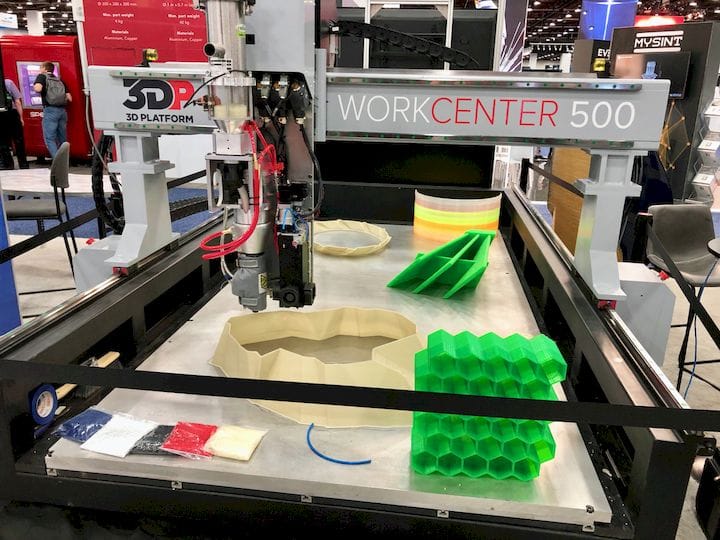![The 3D Platform WorkCenter 500 large format 3D printer [Source: Fabbaloo]](https://fabbaloo.com/wp-content/uploads/2020/05/image-asset_img_5eb0964bb3008.jpg)
3D Platform has produced a rather large 3D printer, the WorkCenter 500, and we had a close look at it.
The build volume on this beast is substantial, at 1400 x 2800 x 700 mm, or 2.7 cubic meters of volume. That should accommodate the needs of many large part-makers.
I know what you’re thinking: this is just another scaled-up desktop 3D printer, what’s the big deal?
![Several high-speed extruders available for the WorkCenter 3D printers from 3D Platform [Source: Fabbaloo]](https://fabbaloo.com/wp-content/uploads/2020/05/image-asset_img_5eb0964bdfef8.jpg)
In fact, the WorkCenter 500 has a number of very interesting features that 3D Platform has developed over the past few years building and selling large-format 3D printers.
One innovation is the type of materials that can be used. More primitive large-format 3D printers of this type would only be able to handle PLA material due to its low tendency to warp. 3D printing a warpy material such as ABS was simply out of the question.
ABS is still out of the question on the WorkCenter 500, but they tell us they can successfully 3D print PETG and some nylons, making the device much more useful than your typical giant PLA machine.
![The huge 3D Platform WorkCenter 500 3D printer includes a massive aluminum build plate [Source: Fabbaloo]](https://fabbaloo.com/wp-content/uploads/2020/05/3d-platform-workcenter-500-plate-1_img_5eb0964c15747.jpg)
High-Speed 3D Printing
Typical large-format 3D printers also suffer terribly from extended print durations. If you think a 6-hour desktop 3D print takes too long, then you will be floored by systems that simply scale up that same technology to result in week-long prints. That’s simply unacceptable, and it turns out 3D Platform has done significant work to overcome this barrier.
The company offers a variety of very advanced hot end extrusion systems that are specifically designed to deliver thermoplastic material far more rapidly than a typical desktop hot end. The standard rate on the WorkCenter 500 is a huge 1kg of material per hour, but there are larger optional extrusion systems that can bring the deposition rate up to an astonishing 6.8kg per hour.
![The 3D Platform WorkCenter 500 has a rather hefty high-speed extrusion system [Source: Fabbaloo]](https://fabbaloo.com/wp-content/uploads/2020/05/3d-platform-workcenter-500-extruder-1_img_5eb0964c42fba.jpg)
Some of that speed increase is due to larger nozzle sizes, which 3D Platform can provide. Their product list includes 0.7mm, 1.4mm and 2.8mm nozzle diameters.
To put that in perspective, that would require you to swap 1kg spools every 8 minutes and 49 seconds. Obviously, 3D Platform uses far larger spool sizes on this machine.
6mm 3D printer filament
While the company does offer pellet-material solutions, one of their more interesting innovations is 6mm diameter filament, seen in this image. The added diameter ensures there is plenty of material to deliver to the hungry high-speed extrusion system, but it is quite rigid. You may be wondering how they can properly unspool such a thick filament and have it pass smoothly through the filament path.
![Thick 6mm 3D printer filament from 3D Platform. Rigid! [Source: Fabbaloo]](https://fabbaloo.com/wp-content/uploads/2020/05/image-asset_img_5eb0964c7254b.jpg)
The answer is that 3D Platform actually pre-heats this thick filament to make it somewhat more pliable and thus able to handle the filament path successfully.
One very intriguing suggestion we heard from the company is their interest in leveraging this thick filament in other ways. Specifically, the thick filament’s diameter could accommodate additions that could not be contemplated with thinner filaments.
One example of this leverage could be the inclusion of much longer fibers. Material vendors today market “carbon fiber” filament, which is essentially PLA or Nylon mixed with very find chopped carbon fibers. While these tiny segments do add some strength to the part, their effect is limited by their length.
But that could change with 3D Platform’s huge 6mm filament. They could potentially add much longer fibers and receive a corresponding strength increase in printed parts. And this would work for any type of fiber, such as glass, which is frequently used instead to carbon fiber these days.
The 3D Platform WorkCenter 500 is available now at a price near US$200K.
Via 3D Platform











FELIXprinters has released a new bioprinter, the FELIX BIOprinter, which is quite a change for the long-time 3D printer manufacturer.